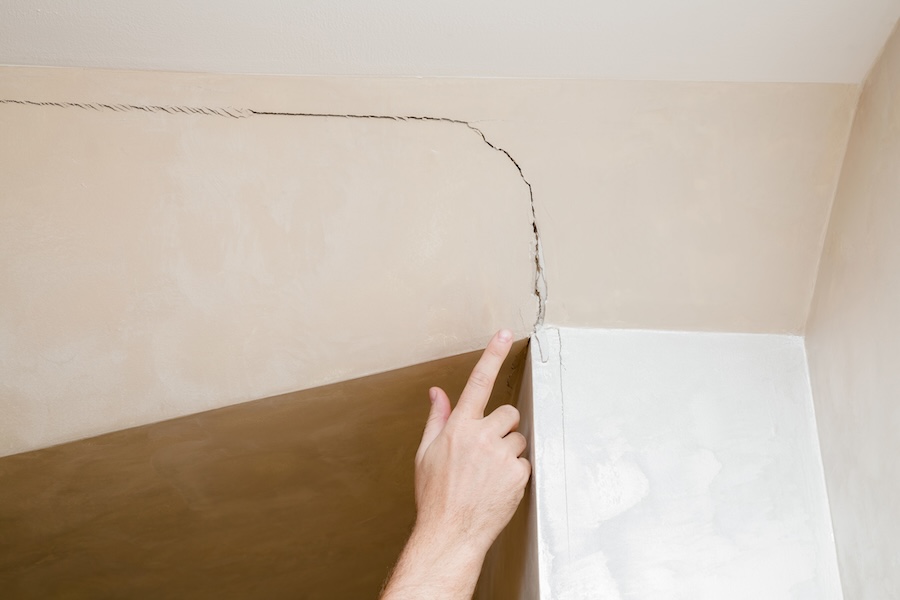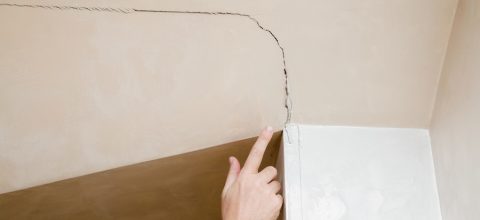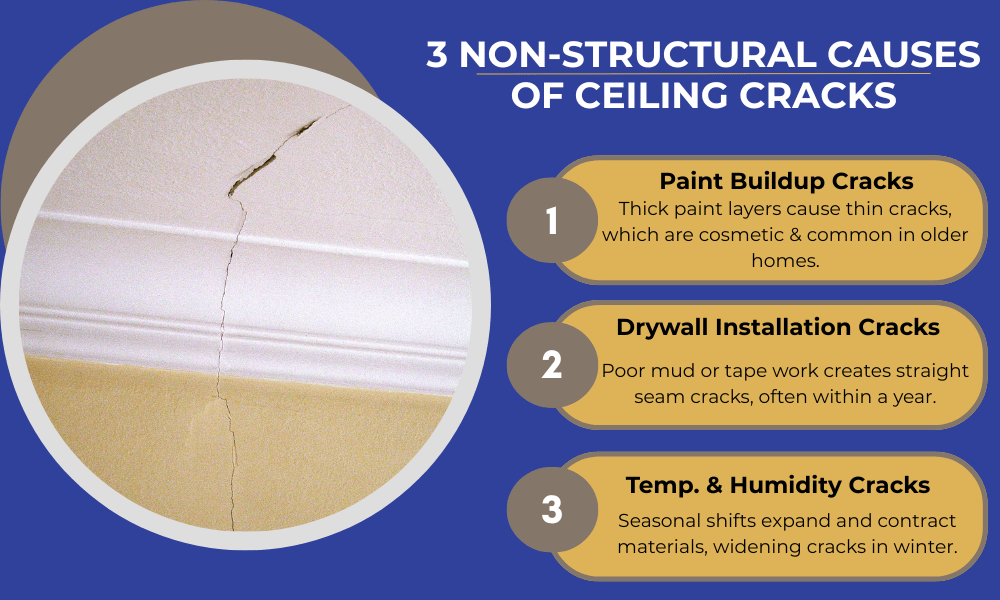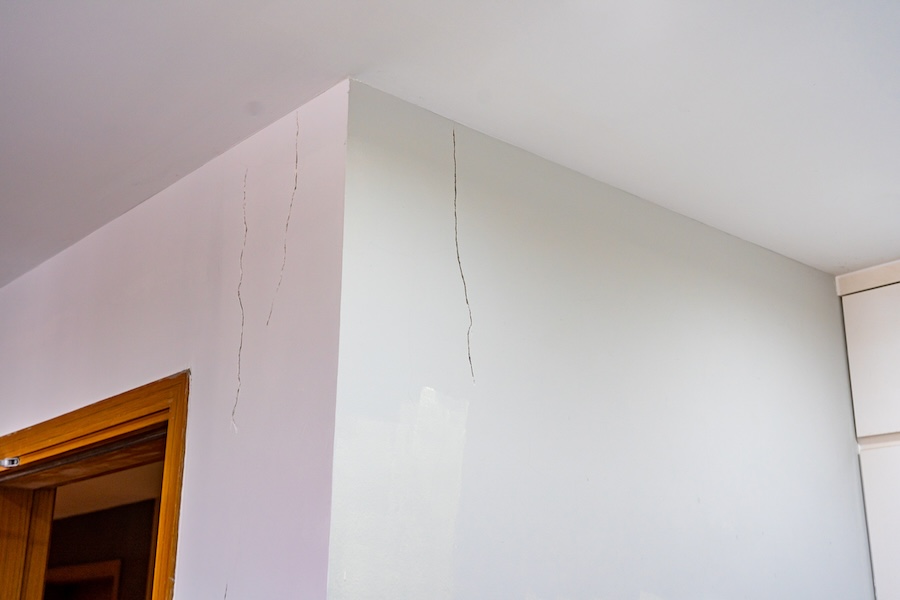Here’s the short answer: Ceiling cracks can result from both harmless cosmetic issues and serious structural problems. Minor cracks often come from paint buildup, improper drywall installation, or normal temperature changes affecting your plaster ceiling. However, larger cracks may signal structural damage from foundation settlement, water damage, or other foundation problems that need immediate attention.
The key is understanding which type of ceiling drywall crack you’re dealing with. A straight crack following drywall tape lines usually indicates installation issues, while spiderweb cracks often point to paint buildup. More concerning signs include ceiling sagging, wide cracks, or damage that spreads from your ceiling to walls.
In this guide, we’ll walk you through identifying different crack types, recognizing red flag warning signs, and knowing when to call a foundation repair contractor. By the end, you’ll understand whether your ceiling issue is a simple cosmetic fix or a serious structural problem requiring professional foundation repair.
Common Non-Structural Causes of Ceiling Cracks
Paint Buildup and Surface Issues
Multiple layers of paint over the years create a thick coating that eventually develops hairline crack networks. These small cracks often appear as spiderweb cracks across your ceiling surface, particularly noticeable in areas like your bathroom ceiling or living room where humidity and temperature changes occur frequently.
Signs of paint-related cracking:
- Very thin crack lines resembling spider webs
- Cracks that follow no particular pattern
- Surface-level damage only
- More common in old house structures with many paint layers
These minor cracks don’t threaten your home’s structural integrity. While they may look unsightly, they represent purely cosmetic issues rather than any structural problem.
Drywall Installation Problems
Poor drywall installation often creates straight crack lines along drywall tape seams. When contractors use too much or too little drywall mud during installation, the ceiling drywall develops stress points that eventually crack.
Common drywall-related issues:
- Straight cracks following tape lines
- Cracks at drywall joints
- Poor mud application during initial installation
- Inadequate drywall tape adhesion
Even in a new house, settling can cause these installation-related ceiling cracks to appear within the first year. These represent a structural issue with the installation process, not your home’s foundation.
Temperature and Humidity Effects
Your drywall ceiling and plaster ceiling materials naturally expand and contract with changing wall temp conditions. This movement creates thin crack patterns, especially in older homes where building materials have less flexibility.
Temperature-related cracking occurs when:
- Seasonal humidity changes affect materials
- Heating and cooling systems create temperature swings
- Poor insulation allows excessive temperature fluctuations
- Normal building movement exceeds material flexibility
These cracks typically open and close with seasonal changes, appearing wider in winter and narrower in summer.
Serious Structural Causes That Require Attention
Foundation Settlement Issues
Foundation settling creates stress throughout your whole house structure, often appearing first as ceiling cracks. Differential settlement happens when your foundation sinks unevenly into the ground, putting enormous pressure on your home’s frame.
Foundation settlement warning signs:
- Cracks that grow progressively wider
- New ceiling crack development over time
- Damage spreading from ceiling to walls
- Multiple crack locations throughout your home
Foundation problems require immediate attention from a foundation repair contractor. Ignoring these signs leads to further damage affecting your home’s structural integrity.
Water Damage and Plumbing Issues
Water infiltration from plumbing issue sources or roof leaks creates serious ceiling problems. Your bathroom ceiling is particularly vulnerable to moisture-related damage from upstairs plumbing or ventilation problems.
Water damage indicators include:
- Discolored ceiling cracks with brown or yellow staining
- Damp or wet crack areas
- Musty odors near damaged areas
- Peeling paint or ceiling material around cracks
Water damage compromises your ceiling’s structural integrity and often indicates larger problems within your home’s systems.
Truss Uplift and Roof Structure Problems
Truss uplift occurs when your roof trusses move due to seasonal temperature and humidity changes. This movement affects the connection between your walls and ceiling, creating cracks where they meet.
Understanding truss uplift:
- Wooden roof trusses naturally expand and contract
- Movement creates stress at wall-ceiling connections
- Cracks may open and close seasonally
- Not immediately dangerous but requires monitoring
While truss uplift itself doesn’t indicate structural damage, it can worsen over time and should be evaluated by professionals who understand the root cause.
Identifying Red Flags and When to Take Action
Certain crack characteristics immediately signal serious problems requiring professional assessment. Learning to distinguish between cosmetic and structural warning signs helps you respond appropriately.
Immediate red flag indicators:
- Ceiling sagging alongside any crack formation
- Larger cracks wider than 1/16 inch
- Diagonal cracks tearing through the drywall material
- Cracks extending from the ceiling down the walls
Progressive Damage Patterns
Monitor how your ceiling cracks change over time. Cracks that remain stable typically indicate minor issues, while growing damage suggests active structural problems.
Signs requiring immediate action:
- Rapid crack growth over days or weeks
- Multiple new ceiling crack formations
- Damage spreading throughout living room, bathroom ceiling, and other areas
- The ceiling material is beginning to separate or fall
When to Call Professionals
Don’t wait if you notice these emergency situations. Some ceiling problems pose immediate safety risks requiring evacuation until a professional assessment occurs.
Call for emergency evaluation when:
- Any ceiling area appears ready to collapse
- Large sections show significant sagging
- You hear cracking or popping sounds from above
- Ceiling material actively falls or separates
Schedule a professional inspection for:
- Cracks wider than a quarter inch
- Multiple crack locations throughout your home
- Any signs that indicate structural damage
- Concerns about your foundation’s condition
Professional Solutions and Expert Foundation Repair
Why Professional Assessment Matters
Properly diagnosing ceiling crack causes requires expertise in structural engineering and foundation systems. A qualified foundation repair contractor can identify the root cause of your ceiling problems and recommend appropriate solutions that prevent further damage to your whole house.
Professional evaluation provides:
- Accurate diagnosis of underlying problems
- Comprehensive structural integrity assessment
- Customized repair recommendations
- Long-term solutions rather than temporary fixes
Comprehensive Foundation Repair Approach
Effective foundation repair addresses not just visible symptoms but underlying causes creating your ceiling problems. This includes evaluating your foundation’s condition, drainage systems, and structural connections throughout your home.
Complete repair solutions include:
- Foundation stabilization and reinforcement
- Drainage and waterproofing improvements
- Structural repairs addressing root causes
- Preventive measures against future settlement
The AMC911 Advantage
For over 30 years, AMC911 Crawl Space & Foundation Repair has provided engineered foundation repair solutions to Hampton Roads families. As Class A contractors with an A+ Better Business Bureau rating, we understand that strong foundations create better living.
Our family-owned business combines decades of experience with modern engineering techniques. Every project receives attention from our in-house engineering team, ensuring solutions tailored to your specific foundation problem.
Don’t let ceiling cracks become major problems. Our team provides free evaluations to determine whether your ceiling issues indicate structural damage requiring immediate attention or simple cosmetic repairs.
We provide foundation repairs, waterproofing services, & masonry repairs to Virginia Beach, Chesapeake, Norfolk, Suffolk, and the entire Hampton Roads area with the same commitment to quality that has guided us for over three decades. When ceiling cracks threaten your home’s structural integrity, our engineered solutions provide permanent fixes that protect your investment.
Contact AMC911 today to schedule your comprehensive structural evaluation and learn how our proven expertise can restore your home’s safety and value.


















